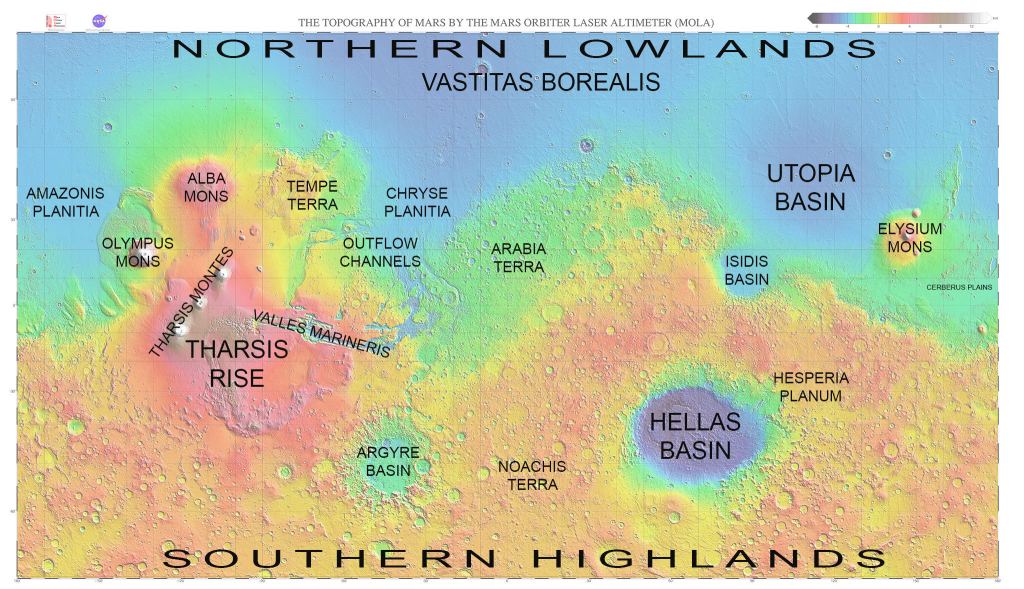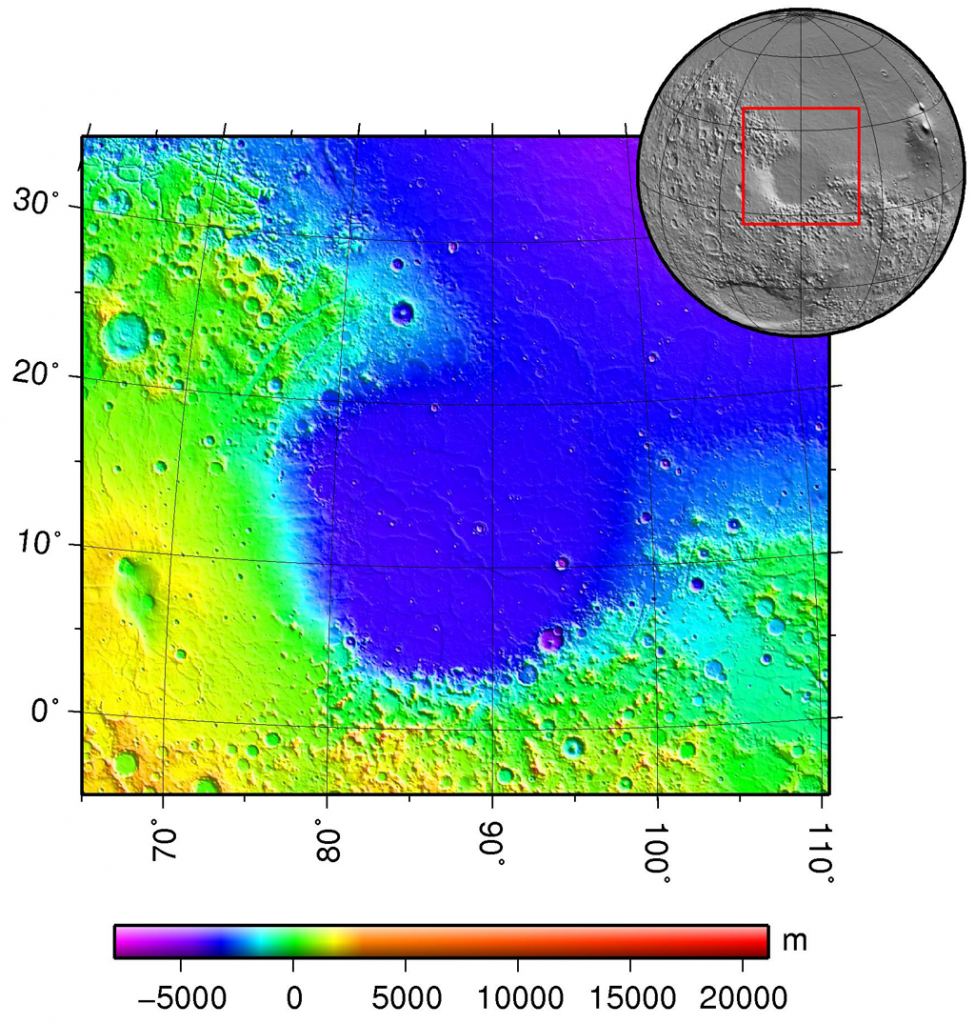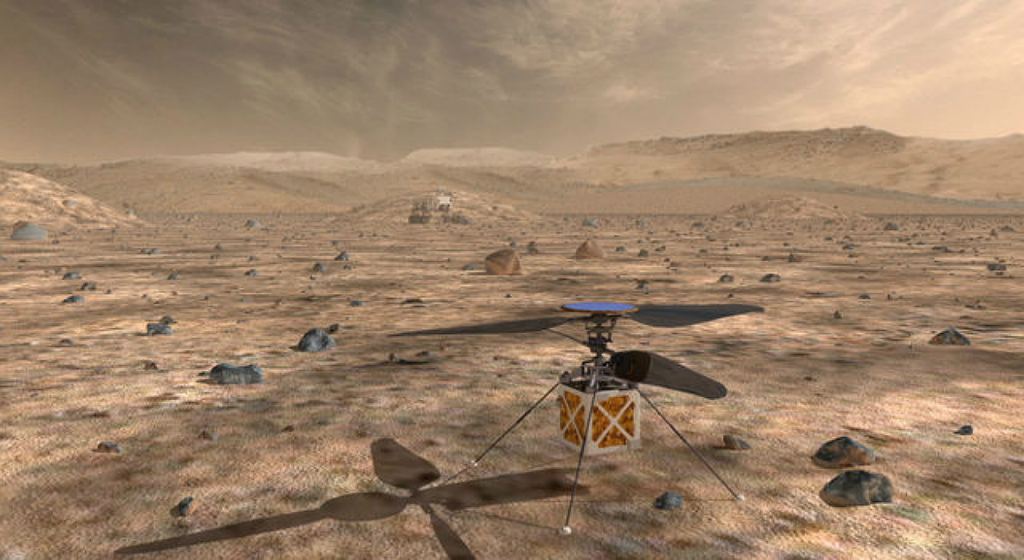Jezero crater is the landing spot for NASA’s upcoming 2020 rover. The crater is a rich geological site, and the 45 km wide (28 mile) impact crater contains at least five different types of rock that the rover will sample. Some of the landform features in the crater are 3.6 billion years old, making the site an ideal place to look for signs of ancient habitability.
Jezero Crater is on the western edge of Isidis Planitia (aka Isidis Basin), which is a giant impact basin just north of the Martian equator. NASA calls the western Isidis Planitia are one of the “oldest and most scientifically interesting landscapes Mars has to offer.” The Jezero Crater was once home to a river delta on ancient Mars, and they think the water and sediments that flowed in the crater billions of years ago may have preserved ancient organic molecules, and possibly other signs of microbial life.

It would be an understatement to say that NASA scientists are excited about the potential.
“Getting samples from this unique area will revolutionize how we think about Mars and its ability to harbor life.” – Thomas Zurbuchen, associate administrator for NASA’s Science Mission Directorate.
“The landing site in Jezero Crater offers geologically rich terrain, with landforms reaching as far back as 3.6 billion years old, that could potentially answer important questions in planetary evolution and astrobiology,” said Thomas Zurbuchen, associate administrator for NASA’s Science Mission Directorate. “Getting samples from this unique area will revolutionize how we think about Mars and its ability to harbor life.”
The site is a double-edged sword, though. The geologic diversity of the site—including clays and carbonates that are very likely to contain preserved signatures of past life, and minerals that were carried into the delta from a large watershed—makes it a scientifically desirable landing spot. But there’s another side to the mission. The entry, descent, and landing of the rover itself.

The Entry, Descent and Landing (EDL) team face a number of challenges. Their job is to deliver the rover safely and intact to the surface of Mars, and Jezero Crater is no golf course. The site contains numerous obstacles and hazards. Near to the site is a massive river delta and plenty of small impact craters. To the east are boulders and rocks, and to the west lie stubborn cliffs. There are also depressions filled with aeolian bedforms in several locations. (Aeolian bedforms are wind-derived ripples in sand that could trap a rover).

“The Mars community has long coveted the scientific value of sites such as Jezero Crater, and a previous mission contemplated going there, but the challenges with safely landing were considered prohibitive,” said Ken Farley, project scientist for Mars 2020 at NASA’s Jet Propulsion Laboratory. “But what was once out of reach is now conceivable, thanks to the 2020 engineering team and advances in Mars entry, descent and landing technologies.”
NASA learned a lot from the MSL Curiosity’s Mars landing at Gale Crater in August 2012, especially in terms of Entry, Descent, and Landing. Curiosity weighed 3839 kg (8463 lb), with 2/3 of that being devoted to the EDL system itself. It’s EDL system allowed it to land within a 20 by 7 km (12.4 by 4.3 mi) landing ellipse. That’s much more accurate than the 150 by 20 km (93 by 12 mi) landing ellipse of the landing systems used by Spirit and Opportunity.
The 2020 rover will use a similar EDL system as Curiosity, but one that’s much more accurate. This bodes well for the 2020 rover and the Jezero Crater. EDL system engineers have reduced the size of the landing zone by 50 percent, meaning a 10 by 3.5 km (6 by 2 mile) landing site. These advances allowed NASA to select Jezero Crater, even with all of its challenges.
NASA has added new capabilities to the “sky-crane” stage of the descent, where rockets are fired to carry the rover down to the surface. The new capabilities are called Terrain Relative Navigation (TRN). The 2020 rover will carry a map of Martian terrain created from orbiter data. As the rover’s cameras monitor the approaching surface, it can compare what it sees to its onboard map so it “knows” where it is. It can then change course to avoid any obstacles.
“Nothing has been more difficult in robotic planetary exploration than landing on Mars,” said Zurbuchen. “The Mars 2020 engineering team has done a tremendous amount of work to prepare us for this decision. The team will continue their work to truly understand the TRN system and the risks involved, and we will review the findings independently to reassure we have maximized our chances for success.”
This is not the first time that Isidis Planitia has been chosen as a landing site. The ill-fated British Beagle 2 lander was destined for the same area when it was lost in December 2003. The scientific desirability of the site hasn’t changed. It may still hold the key to verifying and understanding Mars’ past habitability.
The Mars 2020 rover is different than its predecessors in a couple major ways. Along with gathering data and returning it to Earth via an orbiter, it will also act as the first stage in a Mars sample return mission. The rover will collect samples and store them in a cache, to be retrieved at a later date by a future craft. The sample-return mission will feature three vehicles, a sample-fetching rover, a Mars Ascent Vehicle (MAV), and a new orbiter. The fetching rover would gather the samples and deliver them to the MAV. The MAV will deliver them to the orbiter, and from there an Earth Entry Vehicle would take them to Earth.
“The 2020 rover will help answer questions about the Martian environment that astronauts will face and test technologies they need before landing on, exploring and returning from the Red Planet.” – William Gerstenmaier, NASA.
It will also perform some experiments that will aid future human visitors to Mars. “The 2020 rover will help answer questions about the Martian environment that astronauts will face and test technologies they need before landing on, exploring and returning from the Red Planet,” said William Gerstenmaier, associate administrator for the Human Exploration and Operations Mission Directorate at NASA. The 2020 rover will test the Martian dust to see if it poses a hazard to astronauts. It will also test technology to extract oxygen from atmospheric CO2. Oxygen is not only useful for life support but can also be used in rocket fuel.

The Mars 2020 rover will another vehicle with it, the Mars Helicopter. The tiny helicopter weighs only 1.8 kg (about 4 lbs.) and has a fuselage about the size of a softball. It won’t have a tail rotor but will instead rely on twin counter-rotating main rotors for yaw stability. The Martian atmosphere is of course much thinner than Earth’s, so the rotors will spin at about 3,000 rpm, ten times faster than here on Earth. It’s also fully-automated, since there’s no way to remote-pilot an aircraft from such a long distance.
You can read more about the Mars Helicopter here.
Now that the landing site for Mars 2020 has been chosen, the rover drivers and science operations team can optimize their plans. They can select particularly attractive targets using orbiter data, and they can also avoid particular hazards. The Mars 2020 rover will launch on 17 July 2020, and touch down on Mars on 18 February 2021.
Sources:
- NASA Press Release: NASA Announces Landing Site for Mars 2020 Rover
- NASA Press Release: NASA Announces Mars 2020 Rover Payload to Explore the Red Planet as Never Before
- NASA Press Release: Mars Helicopter to Fly on NASA’s Next Red Planet Rover Mission
- Wikipedia Entry: Mars 2020
- NASA Mars 2020 Rover: Entry, Descent, and Landing Technologies
- Wikipedia Entry: Isidis Planitia
- Research Paper: Major episodes of geologic history of Isidis Planitia on Mars
- Wikipedia Entry: MSL Curiosity
